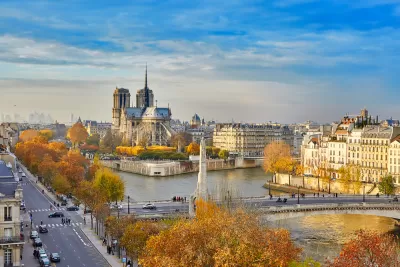Ironically, some of the greatest architecture of the past came from the most nefarious of sources: monarchies and dictatorships. Democratic design, though, can be bland and generic. What of design in our new undemocratic age?

"The trouble is, recent history suggests that (Francis) Fukuyama’s theory (about the ascension of democracy) faces peril, if not outright obliteration. What this world will look like—figuratively and literally—in a generation or two is anyone’s guess. So much for the architecture of democracy. But the continuing process of democratization, and the process of its undoing, has deep implications for actual architecture."
"In my travels to places that have fulfilled Fukuyama’s vision—often heroically—I cannot help but feel a certain lament. While I would never trade freedom for anything as petty as aesthetics (or for anything else, for that matter), I fear that the free world may never again see the type of greatness that those old kings and bishops wrought."
"While history has yet to judge their artistic merit, the autocratic design tradition lives on in Dubai, Baku, and the metropolises of China. Those places are building moments that are superficially distinctive, mostly in the form of high-rises and other places so much larger than life that they seem more grotesque than inspiring. Notre Dame invokes awe at a human scale, as rich in detail as it is impressive in its engineering. The bright skyline of Doha, endless superblocks of Beijing, and odd follies of Baku, do no such thing."
"Many ascendant autocracies are enlisting western architects to build their monuments, in part because they do not have domestic talent capable of slaking their thirst for superlatives. They end up with a sort of cosmopolitan capitalist authoritarianism, in which nations spare no expense to create placelessness."
FULL STORY: Kings, Despots, Dictators, Cities and the End of History

Planetizen Federal Action Tracker
A weekly monitor of how Trump’s orders and actions are impacting planners and planning in America.

Restaurant Patios Were a Pandemic Win — Why Were They so Hard to Keep?
Social distancing requirements and changes in travel patterns prompted cities to pilot new uses for street and sidewalk space. Then it got complicated.

Map: Where Senate Republicans Want to Sell Your Public Lands
For public land advocates, the Senate Republicans’ proposal to sell millions of acres of public land in the West is “the biggest fight of their careers.”

Maui's Vacation Rental Debate Turns Ugly
Verbal attacks, misinformation campaigns and fistfights plague a high-stakes debate to convert thousands of vacation rentals into long-term housing.

San Francisco Suspends Traffic Calming Amidst Record Deaths
Citing “a challenging fiscal landscape,” the city will cease the program on the heels of 42 traffic deaths, including 24 pedestrians.

California Homeless Arrests, Citations Spike After Ruling
An investigation reveals that anti-homeless actions increased up to 500% after Grants Pass v. Johnson — even in cities claiming no policy change.
Urban Design for Planners 1: Software Tools
This six-course series explores essential urban design concepts using open source software and equips planners with the tools they need to participate fully in the urban design process.
Planning for Universal Design
Learn the tools for implementing Universal Design in planning regulations.
Heyer Gruel & Associates PA
JM Goldson LLC
Custer County Colorado
City of Camden Redevelopment Agency
City of Astoria
Transportation Research & Education Center (TREC) at Portland State University
Camden Redevelopment Agency
City of Claremont
Municipality of Princeton (NJ)




























